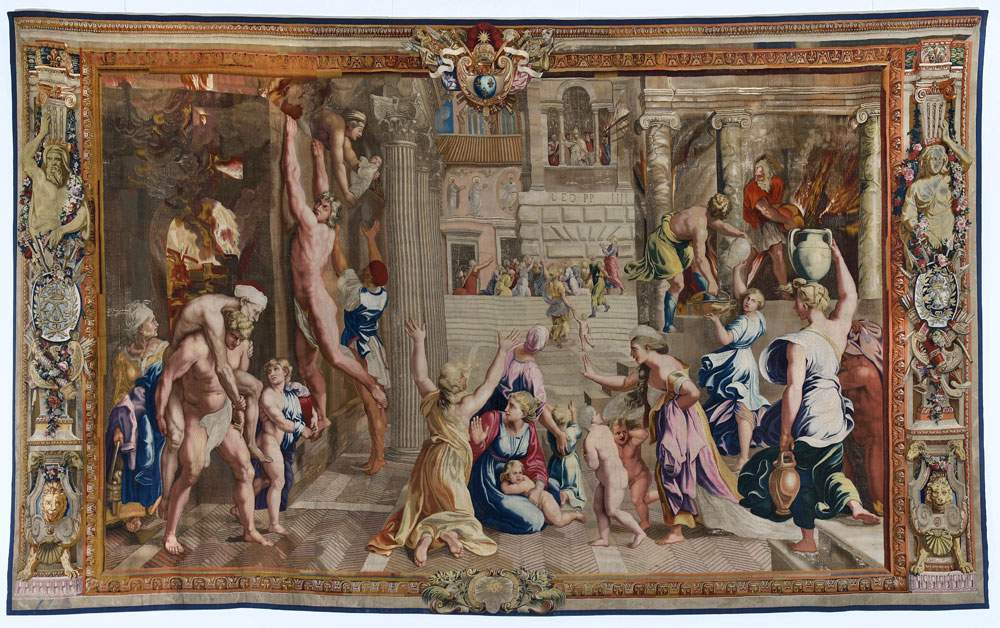At the Galleria Nazionale delle Marche, Raphaelesque tapestries recreate the frescoes of the Vatican Stanze
Opening May 21 at the Ducal Palace in Urbino, home of the Galleria Nazionale delle Marche, is the exhibition On the Thread of Raphael. Enterprise and Fortune in the Art of Tapestry, with which the celebrations for the five-hundredth anniversary of Raphael’s death come to a close.
Curated by Anna Cerboni Baiardi and Nello Forti Grazzini and organized by the Galleria Nazionale delle Marche, in collaboration with the Vatican Museums and the Mobilier National in Paris, the exhibition is on view until September 12, 2021. It is an exhibition that aims to investigate Raphael’s relationship with the world of tapestries, that is, the contribution that the painter made to this field for which he experimented with inventions and made cartoons that were later woven in Flemish workshops, as well as the fortune that the Urbino painter’s works had over the centuries in tapestry production.
Set up in the Salone del Trono (Throne Room), the exhibition presents twelve large works woven in the best tapestries of Europe that depict in particular the works painted in the Vatican Rooms. The very rooms that Raphael had walked through with his father Giovanni Santi welcome his grandest works, the tapestries.
The success achieved by the woven images, re-proposed at different times and in different manufactures, enters fully into the theme of the fortune that the artist experienced over time. Raphael’s art reached the most diverse contexts thanks to engravings, which were much easier to spread; the same thing occurred with tapestries, as the cartoons contributed to the consolidation and enrichment of his fortune.
Visitors, once they enter the Salone del Trono, will find squared off, thanks to the layout by the architects of the Galleria Nazionale delle Marche, the frescoes that the artist created in Rome. Eleven of these come from the Mobilier National in Paris and bear witness to how France, under the reign of Louis XIV, but then until the 19th century, nurtured a true veneration for Raphael, so much so that it conceived the project of recreating in tapestry in Paris, in several replicas, the most celebrated frescoes of Urbino, using on the one hand the French painters of the French Academy residing in Rome to copy the prototypes from life and on the other hand the skill of the tapestry makers framed by Colbert under the Gobelins manufactory, opened in Paris and active exclusively for royal commissions.
In addition to knowledge of this art, the National Gallery of the Marches contributed to the conservation of the precious textiles by financially supporting the restoration of some tapestries from the Mobilier National in Paris.
Accompanying the exhibition is a rich catalog edited by Anna Cerboni Baiardi and Nello Forti Grazzini, published by Silvana Editoriale, which offers a broad overview of the production of tapestries related to Raphael’s world.
For more info: www.gallerianazionalemarche.it
Image: Gobelins Manufacture (by Raphael), The Fire of Borgo (c. 1690; tapestry, 487 x 800 cm; Paris, Mobilier National, inv. GMTT 177). Ph.Credit Isabelle Bideau
 |
| At the Galleria Nazionale delle Marche, Raphaelesque tapestries recreate the frescoes of the Vatican Stanze |
Warning: the translation into English of the original Italian article was created using automatic tools. We undertake to review all articles, but we do not guarantee the total absence of inaccuracies in the translation due to the program. You can find the original by clicking on the ITA button. If you find any mistake,please contact us.




























